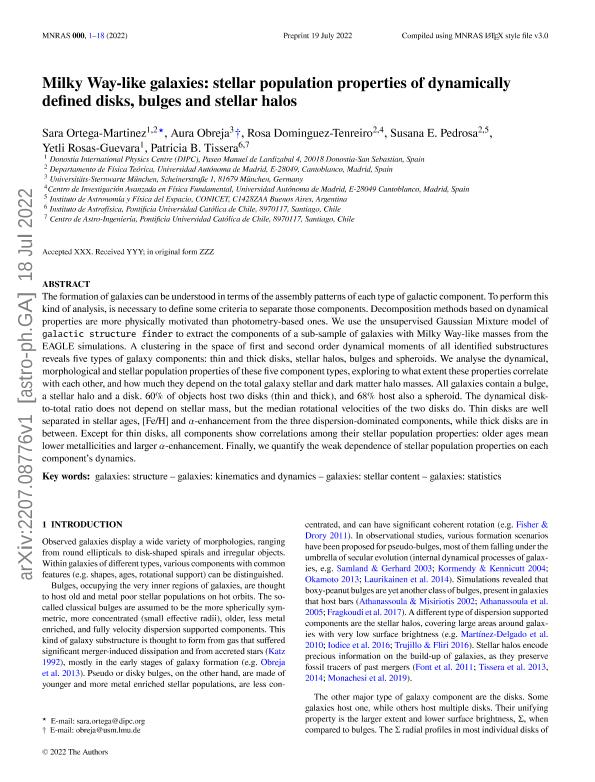Mostrar el registro sencillo del ítem
dc.contributor.author
Ortega-Martinez, Sara
dc.contributor.author
Obreja, Aura
dc.contributor.author
Dominguez Tenreiro, Rosa

dc.contributor.author
Pedrosa, Susana Elizabeth

dc.contributor.author
Rosas Guevara, Yetli
dc.contributor.author
Tissera, Patricia Beatriz

dc.date.available
2023-11-07T12:54:19Z
dc.date.issued
2022-07
dc.identifier.citation
Ortega-Martinez, Sara; Obreja, Aura; Dominguez Tenreiro, Rosa; Pedrosa, Susana Elizabeth; Rosas Guevara, Yetli; et al.; Milky Way-like galaxies: stellar population properties of dynamically defined discs, bulges and stellar haloes; Wiley Blackwell Publishing, Inc; Monthly Notices of the Royal Astronomical Society; 516; 1; 7-2022; 197-215
dc.identifier.issn
0035-8711
dc.identifier.uri
http://hdl.handle.net/11336/217273
dc.description.abstract
The formation of galaxies can be understood in terms of the assembly patterns of each type of galactic component. To perform this kind of analysis, it is necessary to define some criteria to separate those components. Decomposition methods based on dynamical properties are more physically motivated than photometry-based ones. We use the unsupervised Gaussian Mixture model of galactic structure finder to extract the components of a sub-sample of galaxies with Milky Way-like masses from the eagle simulations. A clustering in the space of first- and second-order dynamical moments of all identified substructures reveals five types of galaxy components: thin and thick discs, stellar haloes, bulges and spheroids. We analyse the dynamical, morphological and stellar population (SP) properties of these five component types, exploring to what extent these properties correlate with each other, and how much they depend on the total galaxy stellar and dark matter halo masses. All galaxies contain a bulge, a stellar halo and a disc. In total, 60 per cent of objects host two discs (thin and thick), and 68 per cent host also a spheroid. The dynamical disc-to-total ratio does not depend on stellar mass, but the median rotational velocities of the two discs do. Thin discs are well separated in stellar ages, [Fe/H] and α-enhancement from the three dispersion-dominated components, while thick discs are in between. Except for thin discs, all components show correlations among their SP properties: older ages mean lower metallicities and larger α-enhancement. Finally, we quantify the weak dependence of SP properties on each component's dynamics.
dc.format
application/pdf
dc.language.iso
eng
dc.publisher
Wiley Blackwell Publishing, Inc

dc.rights
info:eu-repo/semantics/openAccess
dc.rights.uri
https://creativecommons.org/licenses/by-nc-sa/2.5/ar/
dc.subject
GALAXIES: KINEMATICS AND DYNAMICS
dc.subject
GALAXIES: STATISTICS
dc.subject
GALAXIES: STELLAR CONTENT
dc.subject
GALAXIES: STRUCTURE
dc.subject.classification
Astronomía

dc.subject.classification
Ciencias Físicas

dc.subject.classification
CIENCIAS NATURALES Y EXACTAS

dc.title
Milky Way-like galaxies: stellar population properties of dynamically defined discs, bulges and stellar haloes
dc.type
info:eu-repo/semantics/article
dc.type
info:ar-repo/semantics/artículo
dc.type
info:eu-repo/semantics/publishedVersion
dc.date.updated
2023-11-06T15:31:53Z
dc.journal.volume
516
dc.journal.number
1
dc.journal.pagination
197-215
dc.journal.pais
Reino Unido

dc.journal.ciudad
Londres
dc.description.fil
Fil: Ortega-Martinez, Sara. Universidad Autónoma de Madrid; España
dc.description.fil
Fil: Obreja, Aura. Technische Universitat München; Alemania
dc.description.fil
Fil: Dominguez Tenreiro, Rosa. Universidad Autónoma de Madrid; España
dc.description.fil
Fil: Pedrosa, Susana Elizabeth. Consejo Nacional de Investigaciones Científicas y Técnicas. Oficina de Coordinación Administrativa Ciudad Universitaria. Instituto de Astronomía y Física del Espacio. - Universidad de Buenos Aires. Facultad de Ciencias Exactas y Naturales. Instituto de Astronomía y Física del Espacio; Argentina
dc.description.fil
Fil: Rosas Guevara, Yetli. Donostia International Physic Center (dipc);
dc.description.fil
Fil: Tissera, Patricia Beatriz. Consejo Nacional de Investigaciones Científicas y Técnicas. Oficina de Coordinación Administrativa Ciudad Universitaria. Instituto de Astronomía y Física del Espacio. - Universidad de Buenos Aires. Facultad de Ciencias Exactas y Naturales. Instituto de Astronomía y Física del Espacio; Argentina. Pontificia Universidad Católica de Chile; Chile
dc.journal.title
Monthly Notices of the Royal Astronomical Society

dc.relation.alternativeid
info:eu-repo/semantics/altIdentifier/doi/http://dx.doi.org/10.1093/mnras/stac2033
Archivos asociados
